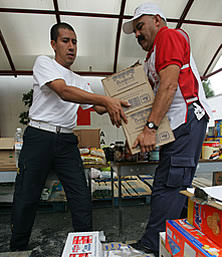 |
 |
 |
 News Around the Republic of Mexico | September 2005 News Around the Republic of Mexico | September 2005  
Mexico Sending Storm Relief Convoy to U.S.
 Mark Stevenson - Associated Press Mark Stevenson - Associated Press


| | Red Cross volunteers arrange donations for Hurricane Katrina victims at the Mexican Red Cross center in the capital on Tuesday. (Photo: AP) |
Mexico City - Radio talk shows and newspapers here buzzed with excitement over news that Mexico, long on the receiving end of U.S. disaster relief, was sending a hurricane aid convoy to help its larger, richer and more powerful northern neighbor.

Carrying water treatment plants, mobile kitchens and supplies to feed victims of Hurricane Katrina, the army convoy bound for Houston will be the first Mexican military unit to operate on U.S. soil since 1846.

The convoy has "a very high symbolic content," said Javier Oliva, a political scientist at Mexico's National Autonomous University. "This is a very sensitive subject, for historic and political reasons."

Large Mexican flags were taped to many of the 35 olive-green Mexican Army trucks and tractor trailers as they rumbled northward toward the border on Wednesday. The convoy was due to cross into Laredo, Texas, early Thursday, President Vicente Fox's office said.

"This is just an act of solidarity between two peoples who are brothers," Fox's spokesman Ruben Aguilar said of the mission.

The trucks, carrying 195 unarmed soldiers, officers and specialists, will apparently be used to provide water and hot meals for people evacuated from the New Orleans area.

The mayor of New Orleans has said thousands may have died from the powerful Aug. 29 hurricane. Hundreds of thousands have been displaced.

The convoy includes two mobile kitchens that can feed 7,000 people a day, three flatbed trucks carrying mobile water treatment plants and 15 trailers of bottled water, blankets and applesauce. It also includes military engineers, doctors and nurses.

"This is the first time that the United States has accepted a military mission from Mexico" for such work, said Javier Ibarrola, a newspaper columnist who covers military affairs in Mexico. "This is something that's never happened before."

The relief mission was controversial for some Mexican senators, who said the president should have sought Senate approval for sending troops.

But the government was already planning another 12-vehicle aid convoy for this week. It has sent a Mexican navy ship heading toward the Mississippi coast with rescue vehicles and helicopters.

The ship Papaloapan left the Gulf coast port of Tampico on Monday and is scheduled to dock Wednesday afternoon in the Mississippi River at a spot about 30 miles south of Biloxi, Miss.

"Military commands on both sides of the border have always been very sensitive about this kind of thing ... as we saw with the (U.S.) Marines when they came to Mexico to perform a funeral," said Oliva.

He was referring to a July 2004 incident in which Mexican troops interrupted the funeral of a Mexican-born Marine killed in Iraq. They had objected to the non-working, ceremonial rifles carried by two Marines who came from the United States for the ceremony.

Mexico later apologized but said it has an obligation to enforce a ban on foreign troops carrying weapons in its territory.

Mexico has sent disaster relief aid missions to other Latin American nations, but not to the United States.

In 1846, Mexican troops briefly advanced just north of the Rio Grande in Texas, which had then recently joined the United States. Mexico, however, did not then recognize the Rio Grande as the U.S. border.

The two countries quickly became mired in the Mexican-American War, which led to the loss of half of Mexico's territory in 1848. | 
 | |
 |



